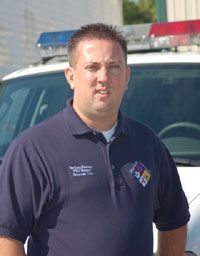By Matt Kapko
FireRescue1 News Editor
Incidents involving carbon monoxide always pose a unique challenge to firefighters and paramedics. Because CO is impossible to see, taste or smell, the toxic gas can cause death before it is even detected.
Brandon Johnson knows better than most just how complicated CO cases can get. A member of one of four regional hazmat response units in northern Kentucky, Johnson found himself in a situation that few firefighters have imagined — one that sent him racing across town to prevent a CO-related tragedy.
|
|
In February 2006, Johnson, a firefighter/paramedic with the Hebron (Ky.) Fire Protection District, and his crew were called to a local hotel in response to a report of a young girl experiencing a potential allergic reaction to chlorine.
Two mothers and their four children had come to the hotel in Hebron, Ky., to use the pool because the pool at their hotel was closed. About an hour after she started swimming, one of the children started feeling sick, prompting the hotel staff to call 911.
Upon arrival, Johnson could tell it was going to be difficult to get clear information.
“The kids were all pretty nervous,” Johnson said. “I think they were a little nervous to talk to our crew so we didn’t get too good of a read from them.”
The squad quickly requested an engine company to come out with a Masimo Rad-57 Pulse CO-Oximeter, a mobile, non-invasive device that allows units to easily perform CO screening on victims. While they waited for the engine company to arrive, the crew’s air monitors began detecting high levels of CO, Johnson said.
Readings showed at least 900 parts per million (ppm) in the indoor pool area and more than 1,200 ppm in the boiler room adjacent to the pool room — both dangerously high and well above the 800 ppm threshold for lethal amounts.
When CO is inhaled, it combines with hemoglobin to form carboxyhemoglobin, or COHb. The average COHb level in nonsmokers is less than 1 percent, while the average level in smokers is about 4 percent. COHb blood saturation levels of 10 to 30 percent can cause headaches, dizziness, nausea and fatigue. Symptoms such as severe nausea, severe headaches, dizziness, and increased pulse and respiration occur at 30 to 50 percent COHb. And COHb levels over 50 percent cause progressive symptoms proceeding to loss of consciousness, collapse, convulsions, coma and, finally, death.
“Obviously, the ability to accurately quantify the percentage of carboxyhemoglobin in patients in the field can have a dramatic effect on patient outcomes,” Johnson said.
By the time the engine company arrived with the CO-Oximeter, the group had left the hotel, despite the crew’s warnings. “Luckily they gave us some cell phone numbers and contact information,” Johnson said.
The crew began testing hotel staff with the CO-Oximeter and detected 16 percent COHb in a maintenance worker who’d been working in the boiler room for about 20 minutes. Johnson and his crew became extremely concerned at that point, knowing the children had been in the pool for about an hour.
The crew quickly called ahead to the dispatch center and tried to explain the situation, while requesting that a closer ambulance also respond to the hotel where the group had returned. “They just weren’t getting it,” Johnson said of the dispatch center, explaining that the dispatcher wasn’t grasping the seriousness of the incident. Nonetheless, the ambulance was dispatched and arrived at the hotel at the same time as Johnson’s crew.
En route to the hotel, Johnson’s crew contacted one of the mothers via cell phone and explained the danger they were in. By the time the group arrived at their hotel in Covington, Ky., all four of the children had vomited, Johnson said.
Johnson and his crew soon arrived and began detecting COHb levels of 20 to 22 percent on all four of the kids and 17 to 18 percent on the mothers. All were immediately taken to hospitals and recovered without incident.
Johnson gives much of the credit for the fortunate outcome to the Rad-57 CO-Oximeter, adding that aside from than taking the patients to a facility or actually witnessing a manifestation of symptoms, there wouldn’t be any way to quantify the seriousness of the problem.
“It couldn’t have been done without that instrument,” Johnson said of the Rad-57. “It’s been really beneficial for us, especially when responding to incidents when the air monitors can’t find the source.”
Ultimately, Johnson’s experience underscores the complexity of CO-related incidents and the need for vigilance by first responders in dealing with them. Had he and his crew been less familiar with the dangers of CO, it’s very conceivable that the six victims might have met a tragic fate.
“I believe that all first responders have an unquestioned responsibility to the citizens (customers) they serve to educate themselves about all of the potential hazards present within their communities. This is certainly true of CO toxicity, as it is extremely common and often misdiagnosed,” Johnson said.
For more information on CO detection and rehabilitation, visit FireRehab.com.


